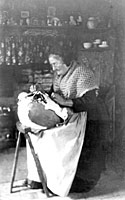![]()
The contents on this page remain on our website for informational purposes only.
Content on this page will not be reviewed or updated.
![]()
The contents on this page remain on our website for informational purposes only.
Content on this page will not be reviewed or updated.
LACEMAKING IN STONY STRATFORD |
|||||
| Lacemaking
The original cottage industry |
 |
||||
| In the 1880s a Stony Stratford lace school was busy producing delicate and beautiful lace ready for sale in Newport Pagnell and Buckingham. The old school was situated on the west side of the High Street, close to the site thought to be where Queen Eleanor's Cross stood. The tradition of lace-making is thought to be a very English craft, but in actual fact it arrived in this country from 1563 onwards, when people escaping religious persecution arrived from the Low Countries. Lace-makers and lace-dealers settled in Britain and thus began a new industry. It was in every sense a cottage industry - a trade generated and sustained by women and girls working in their own homes to earn a meagre amount of money for their craft, typically a few shillings a week. Even men became lace-makers when work was scarce after the harvests etc. Some men found lacemaking was actually more lucrative than working on the land and so it became a long-term job for them. The grand ladies of the stately homes and salons probably gave little thought to who produced the lace they wore - any more than modern consumers bother much about the sweatshop labour in the Far East which produces the cotton shirts and trainers for current internationally-known brandnames. Women would sit outside their homes in daylight, with the lace attached to a pillow resting on a stool (called a pillow horse). Colourful bobbins holding threads were twisted around pins in perforated parchment bearing the pattern for the old point lace. The pins they used were probably made by local pinmaker Edward Lever or from Mr. Sayers' old shop near to Bull's Yard in Stony Stratford. Originally bobbins were made of bone, but were superceded by wooden bobbins. The cotton used in lacemaking was bought in, but everything else was made locally, eg pillows, stools (often made by the family members), bobbins which were carved, along with pins from the two Stony Stratford pinmakers. Villages developed their own particular style and patterns, Stony Stratford's most well-known pattern being the Butterfly.
Speed, a constant rhythm and high output were the order of the day. No talking was allowed! To pass the hours and keep the rhythm steady, the ladies sang old folk songs in the round, such as London's Burning, over and over again. Errors were forbidden and so concentration was vital in keeping the momentum going. The women also used chants called 'tells' and the silence in-between whilst 8 pins were put into the pillow was called a 'glum'. Perhaps if you had passed by you may have heard the following being chanted: 'Jack , be nimble! Jack, be quick! Jack, jump over the candlestick.' or 'Pardon, Mistress, Pardon, Master, Pardon for a pin; If you won't give us a holiday, We won't let you in!' Such was the fame of Buckinghamshire lace that William Shakespeare wrote in Twelfth Night: "Spinsters and knitters in the sun and the free maids weave their threads with bone." Being a lacemaker sounds like an interesting job, but it was far from healthy. Lacemakers would have been easy to spot, being pale-skinned from working many hours (and when the weather was poor, indoors by candlelight). Their eyesight was extremely poor and they often looked deformed and developed a stoop even at a young age.
To read more about the lace industry in Buckinghamshire, visit the following sites: Cowper & Newton Museum Olney - Lace feature Hanslope & District Historical Society - Hanslope lace Stoke Goldington Association - Harry Armstrong and the Bucks Lace Workers Association Modern Lacemaking - Olney Lace Circle |
|||||
|
|
|||||